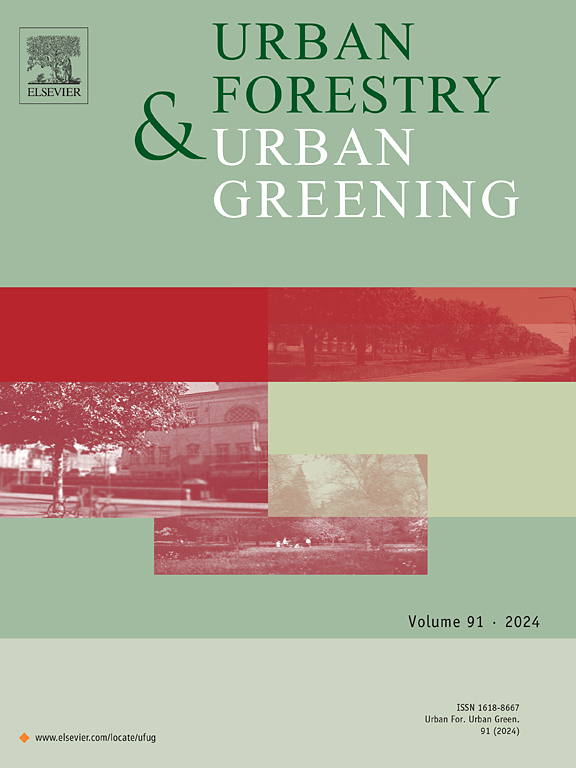在以黑人为主的抽样调查中,户外体育活动与改善心理健康并无关联,但在公园中度过的时间与改善心理健康有关联。
IF 6
2区 环境科学与生态学
Q1 ENVIRONMENTAL STUDIES
引用次数: 0
摘要
户外活动可以通过放松和体育锻炼促进心理健康。然而,大多数研究都是采用自我报告的方式,并涉及来自高收入地区的大多数白人样本。使用设备测量、少数民族参与者或低收入社区的研究结果可能并不成立。我们的目标是测试:i)户外体育活动时间是否与心理健康有关;ii)积极或消极的户外条件(户外活动时遇到的绿化或空置房屋/地块的数量)是否会改变这种影响;iii)我们对户外条件的测量与感知的邻里条件之间是否存在相关性;iv)在公园的户外活动时间(作为有意接触大自然的指标)与心理健康之间是否存在不同的关系。来自密歇根州底特律市 11 个社区的 112 名参与者(87% 为黑人/非裔美国人)在一周内(2021 年 5 月至 10 月)佩戴了 GPS 和加速计,并完成了一项调查。我们计算了户外活动时接触绿化、空地/房屋的情况,以及感知到的社区美感。我们对心理健康指标分别建立了回归模型,并将 PA 中的户外活动时间、年龄、性别和降水量大的日子包括在内。然后,我们根据户外条件进行了分层。最后,我们研究了在公园中的户外活动时间是否也存在类似的关系。平均而言,30% 的体育锻炼是在户外进行的,56% 的户外时间涉及体育锻炼。我们发现,户外活动与焦虑(系数:0.33,95 % CI:0.14-0.51)、抑郁(系数:0.31,95 % CI:0.15-0.47)和感知压力得分(系数:0.18,95 % CI:0.07-0.29)之间存在意想不到的正相关关系。在进行分层时,我们发现那些暴露于高水平空置房屋、高绿化率(包括空中和街道水平)、低水平空置地块和低感知邻里美感的人群具有一致和/或更大的关联。重要的是,与此形成鲜明对比的是,我们在研究在公园度过的时间时发现了相反的趋势(系数:-0.05,95 % CI:-0.10--0.01)。这些结果与许多显示户外活动时间与心理健康之间存在正相关关系的研究形成了鲜明对比,并强调了对不同人群进行研究的必要性,以及对户外条件和接触绿地的意向性进行更好测量的必要性。本文章由计算机程序翻译,如有差异,请以英文原文为准。
Outdoor physical activity is not associated with better mental health in a sample of predominantly Black people, but spending time in parks is
Spending time outdoors may bolster mental health via relaxation and physical activity. Yet, most studies use self-report and involve majority White samples from higher income areas. Findings may not hold true using device-derived measurement, among minoritized participants, or in low-income neighborhoods. Our objectives were to test whether: i) time spent outdoors in physical activity is associated with mental health; ii) the effect is modified by the positive or negative outdoor conditions (amount of greenness or vacant houses/lots encountered while outdoors); iii) there is a correlation between our measures of outdoor conditions and perceived neighborhood conditions; and iv) there is a different relationship between time spent outdoors in parks (as an indicator of intentional nature exposure) and mental health. The sample of 112 participants (87 % Black/African American persons) from 11 Detroit, MI neighborhoods wore a GPS and accelerometer for one week (May-Oct 2021) and completed a survey. We calculated exposure to greenness, vacant lots/houses while outdoors, and perceived neighborhood aesthetics. We fitted regression models for mental health measures separately and included time spent outdoors in PA, age, sex, and days with high precipitation. We then fitted models stratified by outdoor conditions. Last, we examined whether a similar relationship could be detected for time spent outdoors in parks. On average, ∼30 % of PA was conducted outdoors, and 56 % of outdoor time involved PA. We observed an unexpected positive association between outdoor PA and anxiety (coef: 0.33, 95 % CI: 0.14–0.51), depression (coef: 0.31, 95 % CI: 0.15–0.47), and perceived stress score (coef: 0.18, 95 % CI: 0.07–0.29). When stratified, we found consistent and/or larger associations for those exposed to high levels of vacant homes, high greenness (both aerial and street-level), low levels of vacant lots, and low perceived neighborhood aesthetics. Importantly and in contrast, we observed the opposite trend when examining time spent in parks (coef: −0.05, 95 % CI: −0.10--0.01). These results contrast many studies showing positive relationships between time outdoors and mental health and highlight the need for research with diverse populations and better measures of outdoor conditions and intentionality of greenspace contact.
求助全文
通过发布文献求助,成功后即可免费获取论文全文。
去求助
来源期刊

Urban Forestry & Urban Greening
FORESTRY-
CiteScore
11.70
自引率
12.50%
发文量
289
审稿时长
70 days
期刊介绍:
Urban Forestry and Urban Greening is a refereed, international journal aimed at presenting high-quality research with urban and peri-urban woody and non-woody vegetation and its use, planning, design, establishment and management as its main topics. Urban Forestry and Urban Greening concentrates on all tree-dominated (as joint together in the urban forest) as well as other green resources in and around urban areas, such as woodlands, public and private urban parks and gardens, urban nature areas, street tree and square plantations, botanical gardens and cemeteries.
The journal welcomes basic and applied research papers, as well as review papers and short communications. Contributions should focus on one or more of the following aspects:
-Form and functions of urban forests and other vegetation, including aspects of urban ecology.
-Policy-making, planning and design related to urban forests and other vegetation.
-Selection and establishment of tree resources and other vegetation for urban environments.
-Management of urban forests and other vegetation.
Original contributions of a high academic standard are invited from a wide range of disciplines and fields, including forestry, biology, horticulture, arboriculture, landscape ecology, pathology, soil science, hydrology, landscape architecture, landscape planning, urban planning and design, economics, sociology, environmental psychology, public health, and education.
 求助内容:
求助内容: 应助结果提醒方式:
应助结果提醒方式:


